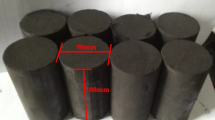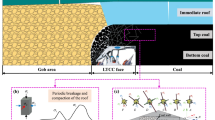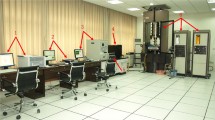Abstract
Deep mining and drilling activities typically trigger significant deformation of coal/rock roadway and even coal/rock dynamic hazards, which has attracted considerable attention. Hence, in this article, the mechanics and failure properties of intact coal are examined through triaxial compression tests and creep tests. First of all, triaxial compression experiments demonstrated that the complete stress–strain curves of intact coal are characterised by Class-I behaviour; and the post-peak modulus is negative. Second, with increasing confining pressure, peak strength and residual strength rise linearly, whereas elasticity modulus and peak strain increase as a power function form. Thirdly, compared with conventional triaxial load, tiered cyclic load can stiffen the strength of intact coal. Moreover, the data of creep tests are successfully fitted to the Burgers model. Maxwell elasticity modulus is significantly smaller than other creep parameters; Maxwell viscosity coefficient shows a positive correlation with deviatoric stress. Contrarily, Kelvin elasticity modulus and Kelvin viscosity coefficient drop with the rise in deviatoric stress. Additionally, with increasing deviatoric stress, single-step creep strain and average creep strain rate, proposed in this study, increase in a power function form. Finally, failure characteristics of intact coal under triaxial stress could be classified into four types (mainly shear failure and multiple shear fractures). The failure-plane angle generally linearly increases with the rise in confining pressure applied.

















Similar content being viewed by others
Abbreviations
- \(B\) :
-
The ratio of circumferential strain to axial strain
- c :
-
Cohesion
- D :
-
Cylinder diameter
- \(E\) :
-
Elasticity modulus
- \(E_{\text{K}}\) :
-
Kelvin modulus
- \(E_{\text{M}}\) :
-
Maxwell modulus
- \(k_{i}\) :
-
Post-peak modulus
- L :
-
Cylinder length
- \(q\) :
-
Axial deviatoric stress
- t :
-
Time
- \(\beta\) :
-
Failure-plane angle
- \(\dot{\varepsilon }_{\text{c}}\) :
-
Average creep rate
- \(\varepsilon_{1}\) :
-
Axial strain
- \(\varepsilon_{\text{creep}} \left( t \right)\) :
-
Axial strain evaluated a certain time instant t
- \(\varepsilon_{3}\) :
-
Circumferential strain
- \(\varepsilon_{\text{p}}\) :
-
Peak strain
- \(\varepsilon_{\text{c}}\) :
-
Single-step creep strain
- \(\eta_{\text{K}}\) :
-
Kelvin viscosity
- \(\eta_{\text{M}}\) :
-
Maxwell viscosity
- \(\mu\) :
-
Poisson’s ratio
- \(\sigma_{n}\) :
-
Effective normal stress imposed on the failure plane
- \(\Delta \sigma_{\text{s}}\) :
-
Intensity difference
- \(\sigma_{2}\) :
-
Intermediate principal stress
- \(\sigma_{1}\) :
-
Major principal stress (axial stress)
- \(\sigma_{3}\) :
-
Minor principal stress (confining pressure)
- \(\sigma_{\text{p}}\) :
-
Peak strength
- \(\sigma_{\text{r}}\) :
-
Residual strength
- \(\varphi\) :
-
Internal friction angle
- CTL:
-
Conventional triaxial load
- SEM:
-
Scanning electron microscope
- TCL:
-
Tiered cyclic load
- TCS:
-
Triaxial compression strength
References
Alkan H, Cinar Y, Pusch G (2007) Rock salt dilatancy boundary from combined acoustic emission and triaxial compression tests. Int J Rock Mech Min Sci 44:108–119. https://doi.org/10.1016/j.ijrmms.2006.05.003
Barbosa K, Esterle J, Chen ZW (2020) Scaling compressive strength from mini-cylinder specimens of sub-bituminous coal. Rock Mech Rock Eng 53:2839–2853. https://doi.org/10.1007/s00603-020-02083-6
Berčáková A, Melichar R, Souček K (2020) Mechanical properties and failure patterns of migmatized gneiss with metamorphic foliation under UCS test. Rock Mech Rock Eng 53:2007–2013. https://doi.org/10.1007/s00603-019-02012-2
Bruce H, Jim G (2017) A review of the geomechanics aspects of a double fatality coal burst at Austar Colliery in NSW, Australia in April 2014. Int J Min Sci Technol 27:3–7. https://doi.org/10.1016/j.ijmst.2016.10.002
Cai W, Dou LM, Si GY, Cao AY, Gong SY, Wang GF, Yuan SS (2019) A new seismic-based strain energy methodology for coal burst forecasting in underground coal mines. Int J Rock Mech Min Sci 123:104086. https://doi.org/10.1016/j.ijrmms.2019.104086
Ding CD, Hu DW, Zhou H, Lu JJ, Lv T (2020) Investigations of P-wave velocity, mechanical behavior and thermal properties of anisotropic slate. Int J Rock Mech Min Sci 127:104176. https://doi.org/10.1016/j.ijrmms.2019.104176
Fuenkajorn K, Phueakphum D (2010) Effects of cyclic loading on mechanical properties of Maha Sarakham salt. Eng Geol 112:43–52. https://doi.org/10.1016/j.enggeo.2010.01.002
Gu HL, Tao M, Li XB, Momeni A, Cao WZ (2019) The effects of water content and external incident energy on coal dynamic behaviour. Int J Rock Mech Min Sci 123:104088. https://doi.org/10.1016/j.ijrmms.2019.104088
Hamza O, Stace R (2018) Creep properties of intact and fractured muddy siltstone. Int J Rock Mech Min Sci 106:109–116. https://doi.org/10.1016/j.ijrmms.2018.03.006
Heap MJ, Baud P, Meredith PG, Bell AF, Main IG (2009) Time-dependent brittle creep in Darley Dale sandstone. J Geophys Res Solid Earth. https://doi.org/10.1029/2008JB006212
Hou RB, Zhang K, Tao J, Xue XR, Chen YL (2019) A nonlinear creep damage coupled model for rock considering the effect of initial damage. Rock Mech Rock Eng 52:1275–1285. https://doi.org/10.1007/s00603-018-1626-7
Jaeger JC, Cook NGW, Zimmerman RW (2007) Fundamentals of rock mechanics, 4th edn. Blackwell Publishing Ltd, Oxford
Jia CJ, Xu WY, Wang RB, Wang SS, Lin ZN (2018) Experimental investigation on shear creep properties of undisturbed rock discontinuity in Baihetan Hydropower Station. Int J Rock Mech Min Sci 104:27–33. https://doi.org/10.1016/j.ijrmms.2018.02.011
Jiang CB, Duan MK, Yin GZ, Wang JG, Lu TY, Xu J, Zhang DM, Huang G (2017) Experimental study on seepage properties, AE characteristics and energy dissipation of coal under tiered cyclic loading. Eng Geol 221:114–123. https://doi.org/10.1016/j.enggeo.2017.03.005
Jiang YJ, Wang YH, Yan P, Luan HJ, Chen YQ (2019) Experimental investigation on the shear properties of heterogeneous discontinuities. Geotech Geol Eng 37:4959–4968. https://doi.org/10.1007/s10706-019-00955-5
Kong XG, Wang EY, He XQ, Zhao EL, Zhao C (2019) Mechanical characteristics and dynamic damage evolution mechanism of coal samples in compressive loading experiments. Eng Fract Mech 210:160–169. https://doi.org/10.1016/j.engfracmech.2018.04.005
Li CB, Gao C, **e HP, Li N (2020) Experimental investigation of anisotropic fatigue characteristics of shale under uniaxial cyclic loading. Int J Rock Mech Min Sci 130:104314. https://doi.org/10.1016/j.ijrmms.2020.104314
Li QC, Wang HP, Yuan L, Wang W, Hou WT, Ma ZW, Zhang QY (2019) Experimental study of damage and degradation of coal by adsorbed gas amount. J China Univ Min Technol 48:955–965. https://doi.org/10.3321/j.issn:1000-6915.2009.05.002
Li ZL, Dou LM, Cai W, Wang GF, Ding YL, Kong Y (2016) Roadway stagger layout for effective control of gob-side rock bursts in the longwall mining of a thick coal seam. Rock Mech Rock Eng 49:621–629. https://doi.org/10.1007/s00603-015-0746-6
Ma LJ, Liu XY, Fang Q, Xu HF, **a HM, Li EB, Yang SG, Li WP (2013) A new elasto-viscoplastic damage model combined with the generalized Hoek-Brown failure criterion for bedded rock salt and its application. Rock Mech Rock Eng 46:53–66. https://doi.org/10.1007/s00603-012-0256-8
Ma XD, Haimson BC (2016) Failure characteristics of two porous sandstones subjected to true triaxial stresses. J Geophys Res Solid Earth 121:6477–6498. https://doi.org/10.1002/2016JB012979
Mansouri H, Ajalloeian R (2018) Mechanical behavior of salt rock under uniaxial compression and creep tests. Int J Rock Mech Min Sci 110:19–27. https://doi.org/10.1016/j.ijrmms.2018.07.006
Masoudian MS, Airey DW, El-zein A (2014) Experimental investigations on the effect of CO2 on mechanics of coal. Int J Coal Geol 128–129:12–23. https://doi.org/10.1016/j.coal.2014.04.001
Mcbeck J, Ben-zion Y, Renard F (2020) The mixology of precursory strain partitioning approaching brittle failure in rocks. Geophys J Int 221:1856–1872. https://doi.org/10.1093/gji/ggaa121
Nicolas A, Fortin J, Regnet JB, Verberne BA, Plümper O, Dimanov A, Spiers CJ, Guéguen Y (2017) Brittle and semibrittle creep of Tavel limestone deformed at room temperature. J Geophys Res Solid Earth 122:4436–4459. https://doi.org/10.1002/2016JB013557
Pan XH, Lü Q (2018) A quantitative strain energy indicator for predicting the failure of laboratory-scale rock samples: application to shale rock. Rock Mech Rock Eng 51:2689–2707. https://doi.org/10.1007/s00603-018-1480-7
Pepe G, Mineo S, Pappalardo G, Cevasco A (2018) Relation between crack initiation-damage stress thresholds and failure strength of intact rock. Bull Eng Geol Environ 77:709–724. https://doi.org/10.1007/s10064-017-1172-7
Rassouli FS, Zoback MD (2018) Comparison of short-term and long-term creep experiments in shales and carbonates from unconventional gas reservoirs. Rock Mech Rock Eng 51:1995–2014. https://doi.org/10.1007/s00603-018-1444-y
Renani HR, Martin CD (2020) Slope stability analysis using equivalent Mohr–Coulomb and Hoek–Brown criteria. Rock Mech Rock Eng 53:13–21. https://doi.org/10.1007/s00603-019-01889-3
Shen XD, Arson C, Ding JH, Chester FM, Chester JS (2020) Mechanisms of anisotropy in salt rock upon microcrack propagation. Rock Mech Rock Eng 53:3185–3205. https://doi.org/10.1007/s00603-020-02096-1
Si XF, Gong FQ, Li XB, Wang SY, Luo S (2019) Dynamic Mohr–Coulomb and Hoek–Brown strength criteria of sandstone at high strain rates. Int J Rock Mech Min Sci 115:48–59. https://doi.org/10.1016/j.ijrmms.2018.12.013
Sone H, Zoback MD (2013) Mechanical properties of shale-gas reservoir rocks—part 2: Ductile creep, brittle strength, and their relation to the elastic modulus. Geophysics 78:393–402. https://doi.org/10.1190/geo2013-0051.1
Sun YT, Li GC, Zhang JF, Qian DY (2019) Stability control for the rheological roadway by a novel high-efficiency jet grouting technique in deep underground coal mines. Sustain 11:6494. https://doi.org/10.3390/su11226494
Tu QY, Cheng YP, Ren T, Wang ZY, Lin J, Lei Y (2019) Role of tectonic coal in coal and gas outburst behavior during coal mining. Rock Mech Rock Eng 52:4619–4635. https://doi.org/10.1007/s00603-019-01846-0
Viete D, Ranjith P (2006) The effect of CO2 on the geomechanical and permeability behaviour of brown coal: implications for coal seam CO2 sequestration. Int J Coal Geol 66:204–216. https://doi.org/10.1016/j.coal.2005.09.002
Wang DK, Lv RH, Wei JP, Fu QC, Wang YT, Zhang P, Yu C, Yao BH (2019) An experimental study of seepage properties of gas-saturated coal under different loading conditions. Energy Sci Eng 7:799–808. https://doi.org/10.1002/ese3.309
Wang YT, Zhou XP, Xu X (2016) Numerical simulation of propagation and coalescence of flaws in rock materials under compressive loads using the extended non-ordinary state-based peridynamics. Eng Fract Mech 163:248–273. https://doi.org/10.1016/j.engfracmech.2016.06.013
Wawersik WR, Fairhurst C (1970) A study of brittle rock fracture in laboratory compression experiments. Int J Rock Mech Min Sci 7:561–575. https://doi.org/10.1016/0148-9062(70)90007-0
**e GX, Yin ZQ, Wang L, Hu ZX, Zhu CQ (2017) Effects of gas pressure on the failure characteristics of coal. Rock Mech Rock Eng 50:1711–1723. https://doi.org/10.1007/s00603-017-1194-2
Xu G, Huang JX, Hu GZ, Yang N, Zhu JQ, Chang P (2020) Experimental study on effective microwave heating/fracturing of coal with various dielectric property and water saturation. Fuel Process Technol 202:106378. https://doi.org/10.1016/j.fuproc.2020.106378
Yang SQ, **g HW, Wang SY (2012) Experimental investigation on the strength, deformability, failure behavior and acoustic emission locations of red sandstone under triaxial compression. Rock Mech Rock Eng 45:583–606. https://doi.org/10.1007/s00603-011-0208-8
Yang SQ, Xu P, Ranjith PG (2015) Damage model of coal under creep and triaxial compression. Int J Rock Mech Min Sci 80:337–345. https://doi.org/10.1016/j.ijrmms.2015.10.006
Yang SQ, Yin PF, Ranjith PG (2020a) Experimental study on mechanical behavior and brittleness characteristics of longmaxi formation shale in Changning, Sichuan basin, China. Rock Mech Rock Eng 53:2461–2483. https://doi.org/10.1007/s00603-020-02057-8
Yang XH, Ren T, Tan LH (2020b) Estimation of average ejection velocity generated by rib burst under compression load. Int J Rock Mech Min Sci 128:104277. https://doi.org/10.1016/j.ijrmms.2020.104277
Yin GZ, Jiang CB, Wang JG, Xu J (2015) Geomechanical and flow properties of coal from loading axial stress and unloading confining pressure tests. Int J Rock Mech Min Sci 76:155–161. https://doi.org/10.1016/j.ijrmms.2015.03.019
Zhan QJ, Zheng XG, Du JP, **ao T (2020) Coupling instability mechanism and joint control technology of soft-rock roadway with a buried depth of 1336 m. Rock Mech Rock Eng 53:2233–2248. https://doi.org/10.1007/s00603-019-02027-9
Zhang L, Li XC, Gao JX, An ZX, Yang XH, Nie BS (2019a) Creep characteristics and constitutive model of coal under triaxial stress and gas pressure. Energy Sci. Eng. 8:501–514. https://doi.org/10.1002/ese3.532
Zhang ZP, **e HP, Zhang R, Zhang ZT, Gao MZ, Jia ZQ, **e J (2019b) Deformation damage and energy evolution characteristics of coal at different depths. Rock Mech Rock Eng 52:1491–1503. https://doi.org/10.1007/s00603-018-1555-5
Zhao J (2000) Applicability of Mohr–Coulomb and Hoek–Brown strength criteria to the dynamic strength of brittle rock. Int J Rock Mech Min Sci 37:1115–1121. https://doi.org/10.1016/S1365-1609(00)00049-6
Zhao J, Feng XT, Zhang XW, Zhang Y, Zhou YY, Yang CX (2018) Brittle-ductile transition and failure mechanism of **** marble under true triaxial compression. Eng Geol 232:160–170. https://doi.org/10.1016/j.enggeo.2017.11.008
Zhou H, Chen J, Lu J, Jiang Y, Meng F (2018) A new rock brittleness evaluation index based on the internal friction angle and Class I stress–strain curve. Rock Mech Rock Eng 51:2309–2316. https://doi.org/10.1007/s00603-018-1487-0
Zhou ZL, Tan LH, Cao WZ, Zhou ZY, Cai X (2017) Fracture evolution and failure behaviour of marble specimens containing rectangular cavities under uniaxial loading. Eng Fract Mech 184:183–201. https://doi.org/10.1016/j.engfracmech.2017.08.029
Acknowledgements
This work was supported by the Natural Science Foundation of Bei**g Municipality (Grant No. 8192036); the National Key Research and Development Program of China (Grant No. 2018YFC0808301); the Youth Foundation of Social Science and Humanity, Ministry of Education of China (Grant No. 19YJCZH087); the State Key Laboratory Cultivation Base for Gas Geology and Gas Control (Henan Polytechnic University) (Grant No. WS2018B04); and the Fundamental Research Foundation for the Central Universities (Grant No. 2009QZ09). The authors also acknowledge Prof. Jian** Wei, Mr **aolong Chen, and Mr Suye Jia for their support during the experimental process. Additionally, the first author would like to express sincere appreciation for the scholarship provided by the China Scholarship Council (CSC No. 201906430024) and University of Wollongong. The authors are grateful for the anonymous reviewers’ insightful comments and thank Mr Kevin Marston for proof-reading the manuscript.
Author information
Authors and Affiliations
Corresponding author
Ethics declarations
Conflict of Interest
The authors declare that there is no conflict of interest.
Additional information
Publisher's Note
Springer Nature remains neutral with regard to jurisdictional claims in published maps and institutional affiliations.
Rights and permissions
About this article
Cite this article
Zhang, L., Li, X. & Ren, T. A Theoretical and Experimental Study of Stress–Strain, Creep and Failure Mechanisms of Intact Coal. Rock Mech Rock Eng 53, 5641–5658 (2020). https://doi.org/10.1007/s00603-020-02235-8
Received:
Accepted:
Published:
Issue Date:
DOI: https://doi.org/10.1007/s00603-020-02235-8




